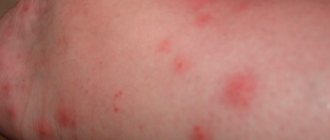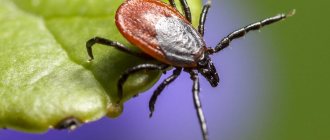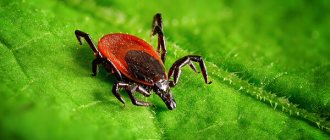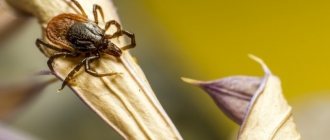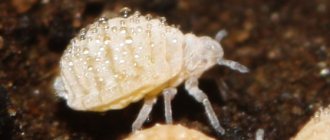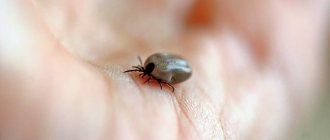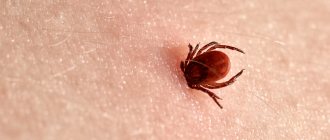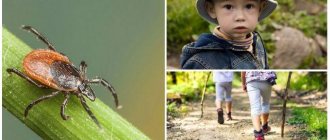What kind of ticks live in the house?
Bed mite.
This microscopic insect, 0.1 to 0.2 mm, belongs to the genus of saprophagous dust mites. It feeds on dead particles of human skin. Causes allergenic reactions.
Ixodid tick.
These insects do not live in the apartment, but can get into it if they are accidentally brought on clothes. An insect can also sneak into a home on the fur of a dog or cat. By the way, animals can also bring scabies mites into the house.
Dust mite.
The insect constantly lives in house dust, barely reaching 0.2 mm in size. Causes severe allergic reactions.
Spider mite.
Lives on indoor plants, causing them harm.
Features of processing
The best time for anti-tick treatment is the beginning of April, when parasites come out of hibernation.
In garden/dacha plots, the event is carried out with preliminary preparation:
- owners of neighboring plots are notified of the time of treatment;
- Everything extraneous is removed from personal plots: furniture, garden equipment, dishes, toys;
- all windows and doors in houses are closed;
- pets and people should be kept at home;
- on the day of treatment and the next day there should be dry, windless weather.
At the end of the treatment, wet cleaning with a soda solution is carried out on stairs, garden swings and other objects on the site. In the treated area there is a ban on collecting fruits, vegetables, mushrooms, and berries for 10 days.
To combat parasites, acaricidal drugs are used - certified products with high efficiency. With their help, it is possible to destroy ticks and prevent the colonization of the treated area by new individuals.
The processing process consists of the following stages:
- a visual inspection of the site is carried out: flower beds, grass, low tree branches are checked;
- selection of optimal drugs against ticks is carried out;
- the area is treated using the cold/hot fog method;
- treatment of the area around the perimeter with a special emphasis on barrier deratization. This must be done because rats are the main source of tick movement.
Chemicals for home control
You can treat your apartment against ticks yourself, provided you follow safety rules. There are many special products on sale:
Bedlam Plus
Acaril
All-Rug
X-mite
Allergoff
"Dobrohim Micro"
"Raid"
Akaitoks
Cypermethrin
Tea tree oil
Spray Easi Ai
VISUAL INSPECTION
After being in the forest, as well as after any walks in nature, thorough self- or mutual examinations are carried out to identify ticks. It is mandatory to inspect your pet after walks. It would be a good idea to regularly check yourself and your pet during the walk. If you remove a tick in time, the likelihood of infection is significantly reduced.
| READ MORE: “How to safely remove a tick? (SIX proven methods)" |
What to do if you are bitten?
What to do if you are bitten by a forest tick? Many people get scared and start doing things that aren’t quite right, dousing the tick with vegetable oil and vodka. It is important to provide first aid correctly, as human health depends on it.
First aid
First aid should be provided by doctors, so it is advisable to go to a special institution so that they can get the forest tick and properly treat the affected area. But if this is not possible, then you should remove the parasite yourself. To do this, you will need forceps, alcohol or chlorhexidine, soap and water.
In almost every pharmacy you can buy a kit that includes tools for extracting forest ticks. You can buy it and take it with you when you go outdoors.
The process itself consists of several stages:
- First, treat your tools with alcohol. The place where the tick sits should also be treated. If possible, wash your hands with soap to avoid introducing another infection through the wound.
- Take tweezers and fix it as close as possible to the head of the parasite. This is very important, because when pulling out a tick, you need to remove it entirely. If the body is torn away from the head, then it will be impossible to get it out on your own. Moreover, as long as part of the tick is under the skin, it continues to poison the human body.
- Having captured the parasite, begin to slowly scroll it counterclockwise. At the same time, you need to pull it slowly and under no circumstances pull it out with all your might.
- Once you have taken out the tick, place it in a container and take it to the laboratory. There they will conduct research and tell you whether the tick was sick and whether the person became infected.
- Wash the wound thoroughly with soap, lubricate it with an antiseptic and bandage it.
Mark the day of the bite on your calendar to monitor whether any symptoms develop and, if so, how quickly.
Once a tick is discovered, action must be taken immediately. No pills, syrups or traditional methods will help. To minimize the possibility of infection, you need to remove the entire parasite as quickly as possible.
Do I need to go to the hospital?
Do I need to go to the hospital after a tick bite? Of course yes! Even if you pulled it out yourself, the doctor should examine the bite site and check whether everything was removed. Moreover, the health station records every forest tick bite, and the victims are under observation for some time (even if the tick was not a carrier of the disease).
A week after the bite, the person who was attacked by the tick must have his blood tested. This should not be neglected even if there are no symptoms, since, for example, Lyme disease develops slowly.
It is necessary to go to the hospital as an emergency if a tick has bitten a person with allergies, immunodeficiency, as well as a child or pregnant woman. Here the clock counts. You should not try to do something yourself, as this can lead to undesirable consequences.
Danger to humans and animals
A tick bite causes discomfort, but it is not the tick that is dangerous, but the pathogens that the parasite carries. Ticks are capable of transmitting some types of infections from one host to another, because during their lives they bite many: people, animals and birds, among whom there are sick ones. These arthropods do not fly or jump, but sit on grass and bushes. When the victim is nearby, with their outstretched front legs they cling to human clothing or animal fur and can crawl over the body for two hours in search of a suitable place to bite. After its implementation, the bloodsucker injects an anesthetic into the wound, but after some time the affected area may still turn red, swollen, itchy and painful. A tick can stay on a person from several days to 2 weeks. Afterwards, if no one pulls it out, the parasite falls off on its own.
Tick-borne diseases
Ticks transmit pathogens of certain diseases:
- spotted fever;
- tick-borne encephalitis;
- tularemia;
- babesiosis;
- borreliosis (Lyme disease);
- spirochetosis (relapsing fever).
Tick-borne infections in animals
An animal becomes infected not only from a bite, but also when it accidentally swallows an arthropod. Here is a list of possible diseases:
- bartonellosis;
- hepatozoonosis;
- ehrlichiosis;
- borreliosis;
- piroplasmosis.
Symptoms of tick-borne borreliosis
As a rule, in the first 20 days after infection there are no symptoms of the disease. But after this, some signs may appear:
— The bite mark changes color and increases in size.
- The appearance of nausea and vomiting. The occurrence of fever and pain in the joints.
— The appearance of characteristic spots, rashes, and nodes on the body.
— Impaired cardiac activity, development of muscle weakness and seizures.
— Several months after infection, disturbances in the functioning of the nervous system may begin.
PLIERS. PREVENTION AND PROTECTION AGAINST TICKS. WHAT SHOULD I DO IF BITTEN BY A TICK?
Ticks (order Acarina, class Arachnida) are one of the most diverse and ancient groups of arthropods on Earth. As a rule, ticks feed on plant debris, soil fungi, or other small arthropods. There are more than 40,000 species of ticks in the world's fauna, however, many groups are still poorly studied, and scientists describe dozens of new species every year. Some ticks have adapted to feeding on the blood of animals and have become parasites. Among the parasites, the most famous are ixodid ticks (Ixodoidea). This group contains a total of 680 species, found on all continents, including Antarctica. Ixodid ticks transmit human pathogens with natural focality: tick-borne encephalitis [the main carriers are the taiga tick Ixodes persulcatus and I. ricinus], tick-borne borreliosis (Lyme disease), tick-borne typhus, relapsing tick-borne typhus, hemorrhagic fever and Q fever, tularemia, ehrlichiosis and many others. Despite the significant number of species of ixodid ticks, only two species are of real epidemiological significance: Ixodes Persulcatus (taiga tick) in the Asian and in a number of areas of the European part, Ixodes Ricinus (European forest tick) - in the European part. In the future we will talk specifically about these types of mites.
Ticks (order Acarina, class Arachnida) are one of the most diverse and ancient groups of arthropods on Earth. As a rule, ticks feed on plant debris, soil fungi, or other small arthropods. There are more than 40,000 species of ticks in the world's fauna, however, many groups are still poorly studied, and scientists describe dozens of new species every year. Some ticks have adapted to feeding on the blood of animals and have become parasites. Among the parasites, the most famous are ixodid ticks (Ixodoidea). This group contains a total of 680 species, found on all continents, including Antarctica. Ixodid ticks transmit human pathogens with natural focality: tick-borne encephalitis [the main carriers are the taiga tick Ixodes persulcatus and I. ricinus], tick-borne borreliosis (Lyme disease), tick-borne typhus, relapsing tick-borne typhus, hemorrhagic fever and Q fever, tularemia, ehrlichiosis and many others. Despite the significant number of species of ixodid ticks, only two species are of real epidemiological significance: Ixodes Persulcatus (taiga tick) in the Asian and in a number of areas of the European part, Ixodes Ricinus (European forest tick) - in the European part. In the future we will talk specifically about these types of mites.
The taiga and European forest ticks are giants compared to their “peaceful” counterparts; their body is covered with a powerful shell and equipped with four pairs of legs. In females, the coverings of the back part are capable of greatly stretching, which allows them to absorb large amounts of blood, hundreds of times more than the weight of a hungry tick.
Males are somewhat smaller in size than females and attach only for a short time (less than an hour). In the surrounding world, ticks navigate mainly through touch and smell; ticks do not have eyes. But ticks’ sense of smell is very acute: studies have shown that ticks are able to smell an animal or person at a distance of about 10 meters.
What places are at greatest risk of encountering ticks?
Ticks are moisture-loving, and therefore their numbers are greatest in well-moistened places. Ticks prefer moderately shaded and moist deciduous and mixed forests with dense grass and undergrowth. There are many ticks along the bottom of ravines and forest ravines, as well as along forest edges, in thickets of willow trees along the banks of forest streams. In addition, they are abundant along forest edges and along forest paths overgrown with grass.
It is very important to know that ticks concentrate on forest paths and paths covered with grass along the side of the road. There are many times more of them here than in the surrounding forest. Studies have shown that ticks are attracted to the smell of animals and people who constantly use these paths when moving through the forest.
Some features of the placement and behavior of ticks have led to the widespread misconception in Siberia that ticks “jump” on people from birch trees. Indeed, in birch forests there are usually a lot of ticks. And a tick clinging to clothing crawls upward, and is often found on the head and shoulders. This gives the false impression that the ticks fell from above.
Tick behavior
The first active adult ticks appear at the end of March, at the beginning of April, when the sun begins to warm up and the first thawed patches form in the forest. The number of ticks increases rapidly, reaching a maximum by the beginning of the second ten days of May, and remains high until the middle or end of June, depending on the weather. Then it sharply decreases due to the extinction of ticks, whose reserve nutrients are depleted. However, single active parasites can be found until the end of September.
Ticks lie in wait for their prey, sitting on the ends of blades of grass, blades of grass, sticks and twigs sticking up.
When a potential victim approaches, ticks assume a posture of active anticipation: they extend their front legs and move them from side to side. On the front legs there are organs that perceive odors (Haller's organ). Thus, the tick determines the direction towards the source of the smell and prepares to attack the host.
Ticks are not particularly mobile; they can travel no more than ten meters on their own in their lifetime. A tick lying in wait for its prey climbs a blade of grass or a bush to a height of no more than half a meter and patiently waits for someone to pass by. If an animal or person moves in close proximity to a tick, its reaction will be immediate. With his front legs spread out, he frantically tries to grab his future owner. The legs are equipped with claws and suction cups, which allow the tick to grip securely. No wonder there is a saying: “He grabbed like a tick.”
With the help of hooks that are located at the very end of the front legs, the tick clings to everything that touches it. Ixodid ticks (European forest tick and taiga tick) never pounce and never fall (do not plan) on the victim from above from trees or tall bushes: ticks simply cling to their victim, who passes by and touches the blade of grass (stick) on which it sits mite.
Having settled on the animal, the tick chooses a place to feed. In most cases, this is the area of the head and neck, where the animal cannot reach with its teeth and destroy the parasite. Then it plunges its mouth parts (the so-called proboscis) into the skin and, cutting through it, reaches the subcutaneous blood vessels, from where it sucks blood. The teeth on the proboscis, directed backwards, and the first portion of saliva, which quickly hardens and glues the oral organs to the skin, like cement, help it securely gain a foothold.
Female ticks feed for about 6 days, absorbing an incredible amount of blood, a well-fed female becomes the size of the phalanx of the little finger, her integument acquires a dirty gray color with a metallic tint, and her weight increases by more than a hundred times compared to the weight of a hungry individual.
Males attach themselves for a short time in order to replenish the supply of nutrients and water in the body; they are mainly busy searching for feeding females with whom they mate.
Parasitism
Ticks parasitize almost all species of forest animals and livestock, as well as many species of birds that feed on the ground. The main groups of feeders are: large mammals - ungulates and carnivores, such as, for example, deer and foxes, large and small rodents - hares, squirrels, chipmunks, voles, shrews. Adults readily attack humans. In animals, ticks most often attach themselves to the head, especially behind the ears, on the neck, dewlap and groin area. In humans, attached parasites are usually found in the armpits, groin area and scalp.
How does a person become infected?
The sucked tick begins to secrete saliva into the resulting wound. The salivary glands of ticks are huge, occupying almost the entire body. The first portion of saliva hardens in air and forms the so-called “cement secretion”, which firmly adheres the proboscis to the skin. Liquid saliva, subsequently secreted, contains a lot of various biologically active substances. Some of them anesthetize the wound, others destroy the walls of blood vessels and surrounding tissues, and others suppress the hosts’ immune responses aimed at rejecting the parasite. The blood and particles of destroyed tissue entering the wound are diluted with saliva and absorbed by the tick.
Together with the saliva of the tick, the virus enters the animal or human body, and if the dose of the virus is large enough, a disease may develop. As studies have shown, the above-mentioned “cement secretion” can contain up to half of the total amount of virus contained in the tick. Therefore, even if you remove the tick almost immediately after it has attached itself, you can still become infected, in this case the source of infection will be the “cement” remaining in the skin. It has also been proven that the infection is transmitted by the bite of males. A short and painless bite from a male may not be noticed. Most likely, quite common cases of tick-borne encephalitis, when patients deny the tick bite, are associated precisely with an attack by males.
Natural foci of tick-borne encephalitis existed long before the appearance of humans in Siberia. The most important role in maintaining natural foci of infection belongs to small forest animals - voles, mice, shrews, squirrels and chipmunks. The animals themselves are susceptible to infection; the virus multiplies well in their bodies, but the disease proceeds without visible harmful consequences.
Although the virus actively reproduces in wild forest animals, they do not exhibit pathological disorders characteristic of the human disease.
Infected wild forest animals, which have the virus in their bloodstream, serve as a source of infection for ticks that feed on them.
Adult ticks pose a danger to humans.
Preventing tick bites
Ticks usually wait for the victim, sitting on the grass or branch of a bush, and very rarely rise to a height of more than half a meter. Therefore, they usually cling to a person’s legs and then “crawl” upward in search of a convenient place for suction. By dressing properly, you can periodically remove ticks from your clothes, preventing them from “getting to your body.”
When in tick habitats, avoid dark-colored clothing, as ticks are more difficult to see against a dark background. Tuck your outerwear into your pants and your pants into your socks. If there is no hood, wear a hat.
Carry out preventive examinations. Every 15 min. inspect your clothes, and at rest stops, if possible, do a more thorough check, examining the head and body, especially above the waist; ticks most often stick there.
Use chemical repellents against ticks. Treat clothes, sleeping bag, tent and other items.
In addition to treating clothing, a protective repellent can be applied to bare areas of the body, which, in addition to tick bites, will protect the treated areas from the bites of blood-sucking insects. If you are constantly in a limited area (summer cottage) where ticks live, then this area can be treated with a special insectoacaricidal agent that kills ticks.
There are always more ticks on the trails, so it’s easier for them to find victims. Therefore, you should not rest, “falling” on the grass a meter from the path. There are fewer ticks in sunny, dry glades than in the shade.
When constructing huts and other shelters in the spring, autumn and winter, it should be remembered that ticks overwinter in forest litter and dry grass and, having warmed up, can attack a person.
Inspect clothing and other items upon returning from a hike
After you come home, take off your clothes outside the living area and carefully inspect them, paying special attention to folds, seams, and pockets.
Leading Russian entomologists have developed special anti-encephalitis suits (for example, BioStop®). Today, thanks to the combination of mechanical and chemical protection principles, these suits are an effective remedy against ticks. Special flounces located on the suit act as traps for ticks crawling upward. Inside the shuttlecock there is an insert impregnated with an acaricidal substance that is lethal to ticks. Under its influence, the tick dies within a few minutes and falls off the clothing.
Thus, when using anti-encephalitis suits, there is no need to use repellents and conduct frequent inspections of clothing.
Tick protection
All commercially available products, depending on the active substance, are divided into 3 groups:
Repellent - repels ticks.
Acaricidal - kill
Insecticidal-repellent - preparations of combined action, that is, they kill and repel ticks.
Repellents
Repellents include products containing diethyltoluamide: “MEDILIS-from mosquitoes”, “Biban”, “DEFI-Taiga”, “Off! Extreme", "Gall-RET", "Gal-RET-cl", "Deta-VOKKO", "Reftamid maximum". They are applied to clothing and exposed areas of the body in the form of circular stripes around the knees, ankles and chest. The tick, avoiding contact with the repellent, begins to crawl in the opposite direction. The protective properties of treated clothing last up to five days. The advantage of repellents is that they are also used to protect against midges, applied not only to clothing, but also to the skin. Preparations that are more dangerous for ticks should not be applied to the skin.
To protect children, drugs with less toxic components have been developed - these are the MEDILISIC anti-mosquito aerosol for children, Fthalar and Efkalat creams, Off-children and Biban-gel, Pikhtal and Evital colognes, "Camarant".
Acaricides
In acaricidal agents, the active substance is the insectoacaricide alphamethrin (alphacypermethrin), which has a nerve-paralytic effect on ticks. Upon contact with treated clothing, ticks become paralyzed in their limbs and fall off the clothing.
These products are intended only for the treatment of clothing due to toxicological indicators and should not be applied to human skin!
The main form of application: aerosol packages containing propellant and with a mechanical sprayer (propellant-free packaging - BAU). These are “Reftamid taiga”, “Picnic-Antiklesh”, “Gardex aerosol extreme”, “Tornado-antiklesh”, “Fumitox-antiklesh”, “Gardex-antiklesh” and others. Currently, about 30 such drugs are registered. An exception is the acaricidal block "Pretix", produced in Novosibirsk. They draw several encircling stripes on trousers and jackets before going into the forest. You just need to ensure their safety, as the strips fall off quite quickly.
Do not treat clothing worn by people with products in aerosol containers. The clothes are laid out, processed and, after they have dried, put on. The protective properties of clothing treated with an acaricidal substance last up to 14 days.
Insecticidal and repellent agents
Insecticidal-repellent preparations combine the properties of both repellent and acaricidal agents - they contain 2 active ingredients: diethyltoluamide and alphamethrin, therefore they protect against ticks and blood-sucking flying insects (the “gnus” complex).
Insecticidal and repellent products are produced in aerosol packages: “Medilis-comfort”, “Kra-rep”, “Moskitol-spray Special protection against ticks”, “GardexExtreme Aerosol against ticks”, “Tick-kaput aerosol”. Just like acaricides, insecticidal-repellent agents are applied only to clothing.
General recommendations when using chemical protection products
You can reliably protect yourself from tick bites only by “dressing correctly” and thoroughly treating your clothes with a chemical protective agent.
When choosing a means of protection against ticks, it is better to give preference to acaricidal or insecticidal-repellent agents.
The products should be applied to clothing in circular strips; clothing should be especially carefully treated around the ankles, knees, hips, waist, as well as sleeve cuffs and collars.
When using this or that product, be sure to read the instructions and follow their instructions. Do not forget to reapply the product after the time indicated on the package.
We must remember that rain, wind, heat, sweat, etc. reduce the duration of action of any chemical protective agent.
Treating the area against ticks
To treat the territory against ticks, the following insectoacaricidal agents are currently allowed in the Russian Federation: “Medilis-tsiper”, Taran, Samarovka-insecticide, Breeze, Akaritoks, Alfatrin, Actor, Akarotsid, Cypertrin, Yurax, Akarifen, Baytex 40% SP, and so on.
What to do if ticks are indoors
For most types of ticks, human housing is not suitable for comfortable living and procreation, however, for a sufficiently long time (up to several weeks), ticks found in the room can pose a danger and, if the opportunity arises, attack a person.
The Institute of Disinfectology does not recommend treating residential premises against ticks (including from a toxicological point of view); the instructions for use of any acaricidal agent say: “treatment against ticks only in natural areas.”
If ticks are found in the room, carpets should be removed from the floor and thoroughly cleaned using a vacuum cleaner.
Prevention of tick-borne encephalitis
Before traveling to an area with an increased risk of contracting tick-borne encephalitis, you should get vaccinated in advance; it can be given at the district clinic.
To prevent tick-borne encephalitis, the following vaccines are approved for use in Russia: tick-borne encephalitis vaccine, culture purified concentrated inactivated dry (produced in the Russian Federation); EnceVir (produced in the Russian Federation); FSME-Immun Inject/Junior (made in Austria); Encepur Adult and Encepur Children (made in Germany).
For the majority of vaccinated people to develop immunity, 2 vaccinations with an interval of 1 month are enough. If necessary, this interval can be reduced to 2 weeks. However, to develop full and long-term (at least 3 years) immunity, it is necessary to receive a third vaccination after 9-12 months. If the need to go to an endemic area does not allow you to wait 2 weeks, then emergency prophylaxis can be carried out using immunoglobulin. In this case, the protective effect occurs within a day, but does not last more than 1 month.
Buy the drug Yodantipirin in advance (used for emergency prevention of tick-borne encephalitis in adults and children over 14 years of age). Theoretically, this drug is capable of destroying the tick-borne encephalitis virus within several days from the moment of infection (tick bite), but it is better to start taking it on the first day.
In the event of a tick bite in children, for the purpose of emergency prevention of tick-borne encephalitis, it is recommended to use “Anaferon for children” in doses: at the age of up to 12 years, 1 tablet 3 times a day, at the age of over 12 years, 2 tablets 3 times a day for 21 days (incubation period period of tick-borne encephalitis), which prevents the development of the disease.
When in mountainous and wooded areas, wear light-colored clothing (it makes ticks easier to see) with long sleeves and a hood, and tuck your pants into your socks. If there is no hood, wear a hat.
Use repellent.
Every 15 min. inspect your clothes, and periodically conduct a thorough check, paying special attention to the following parts of the body: neck, armpits, groin area, ears - in these places the skin is especially delicate and thin, and the tick is most often attached there.
Avoid drinking raw milk from goats and cows in areas with increased risk of infection.
If you find a tick, you should not crush it, as through microcracks on your hands you can become infected with tick-borne encephalitis or other tick-borne infections.
What should I do if bitten by a tick
If tick suction does occur, an initial consultation can always be obtained by calling 03. To remove the tick, you will most likely be sent to the district SES or the district emergency room. If you do not have the opportunity to seek help from a medical facility, then you will have to remove the tick yourself.
It should be borne in mind that the likelihood of contracting infections transmitted by ticks depends on the amount of infection that penetrated during the “bite” of the tick (that is, the time during which the tick was in an attached state) - the sooner you remove the embedded parasite, the better.
It is convenient to remove ticks with curved tweezers or a surgical clamp; in principle, any other tweezers will do. In this case, the tick must be grabbed as close to the proboscis as possible, then it is carefully pulled up, while rotating around its axis in a convenient direction. Usually, after 1-3 turns, the entire tick is removed along with the proboscis. If you try to pull the tick out, there is a high probability of it breaking.
There are special devices for removing ticks.
These devices have an advantage over clamps or tweezers, since the body of the tick is not compressed, squeezing the contents of the tick into the wound is prevented, this reduces the risk of contracting tick-borne infections.
The devices for removing ticks Uniclean Tick Twister (UNICLEAN TICK TWISTER), a lasso handle for the Russian-Swedish one, have proven themselves well.
If you have neither tweezers nor special devices for removing ticks at hand, then the tick can be removed using a thread.
A strong thread is tied into a knot as close as possible to the tick's proboscis, then the tick is removed by slowly swinging and pulling it up. Sudden movements are unacceptable - the tick will burst.
Removing a tick must be done with care, without squeezing its body, since this may squeeze the contents of the tick along with pathogens into the wound. It is important not to tear the tick when removing it - the remaining part in the skin can cause inflammation and suppuration. It is worth considering that when the head of the tick is torn off, the infection process can continue, since a significant concentration of the tick-borne encephalitis virus is present in the salivary glands and ducts.
If, when removing the tick, its head, which looks like a black dot, comes off, wipe the suction site with cotton wool or a bandage moistened with alcohol, and then remove the head with a sterile needle (previously calcined in a fire) in the same way as you remove an ordinary splinter.
There is no basis in some advice that for better removal one should apply ointment bandages to the attached tick or use oil solutions. The oil can clog the tick's respiratory openings and the tick will die, remaining in the skin. After removing the tick, the skin at the site of its attachment is treated with tincture of iodine or alcohol. A bandage is usually not required.
What are the dangers of a tick bite? Medicines and vaccines
Even if the tick bite was short-lived, the risk of contracting tick-borne infections cannot be excluded, therefore, after removing the tick, save it for testing for tick-borne infections. Usually this can be done in an infectious diseases hospital, in special laboratories. The tick should be placed in a small glass bottle along with a piece of cotton wool lightly moistened with water. Be sure to close the bottle with a tight lid and store it in the refrigerator. For microscopic diagnosis, the tick must be delivered to the laboratory alive. Even individual tick fragments are suitable for PCR diagnostics.
You need to understand that the presence of an infection in a tick does not mean that a person will get sick. A tick analysis is needed for peace of mind in case of a negative result and vigilance in case of a positive result.
The surest way to determine the presence of the disease is to take a blood test. There is no need to donate blood immediately after a tick bite - tests will not show anything. No earlier than 10 days later, you can test your blood for tick-borne encephalitis and borreliosis using the PCR method. Two weeks after a tick bite, test for antibodies (IgM) to the tick-borne encephalitis virus. For antibodies (IgM) to borrelia (tick-borne borreliosis) - in a month.
Tick-borne encephalitis is the most dangerous of tick-borne infections (consequences can even lead to death). Emergency prevention of tick-borne encephalitis should be carried out as early as possible, preferably on the first day.
Emergency prevention of tick-borne encephalitis is carried out using antiviral drugs or immunoglobulin. In the Russian Federation this is Yodantipirin for adults and children over 14 years old. Anaferon for children under 14 years old. If you could not find these drugs, theoretically they can be replaced by other antiviral drugs (cycloferon, arbidol, remantadine...).
Immunoglobulin is advisable only during the first three days. Disadvantages include high cost and frequent allergic reactions.
No earlier than 10 days later, you can test your blood for tick-borne encephalitis using the PCR method. Two weeks after a tick bite, test for antibodies (IgM) to the tick-borne encephalitis virus. If a person is vaccinated against the tick-borne encephalitis virus, no action needs to be taken.
Tick-borne borreliosis is the second most dangerous and most common tick-borne disease in the Russian Federation. Emergency prevention of tick-borne borreliosis, as a rule, is not carried out if it is possible to donate blood for antibodies to tick-borne borreliosis (IgM). It is better to take the test 3 weeks after the tick bite. If the result is positive, you need to contact an infectious disease specialist.
Hemorrhagic fevers are a group of naturally focal viral diseases transmitted from animals to humans, united by common clinical signs - increased temperature (fever), subcutaneous and internal hemorrhages. Depending on the causative agent, as well as on the method of spreading the infection, several types are distinguished.
Omsk hemorrhagic fever was first described among residents of lakeside villages in Siberia, among hunters and members of their families, in the Barabinsk steppe. Natural foci of Omsk hemorrhagic fever were found in the Omsk, Novosibirsk, Kurgan, Tyumen and Orenburg regions. It is possible that they are also present in some neighboring territories (Northern Kazakhstan, Altai and Krasnoyarsk territories). It occurs in the autumn-winter period in the form of outbreaks that are associated with epizootics in commercial animals. The main vectors of the disease are Dermacentor ticks. The incubation period is 3-7 days. In humans, the virus is detected throughout the febrile period. Currently, cases of the disease are reported extremely rarely. Yodantipyrine can be used for emergency prevention of hemorrhagic fever with renal syndrome.
